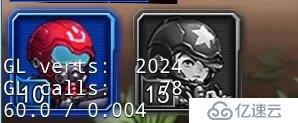先上效果图:

借鉴了[Cocos2d-x 让精灵图像变灰的方法]。
但这个方法在Quick-Cocos3.2下不能完美实现变灰效果-变灰了的对象的位置会跳到屏幕右上角。
百思不得其解,搜一下有没有人发现这个问题,果然有:
[关于Sprite的setShaderProgram后坐标改变的问题]
发现4楼的仁兄的回复有亮点:
[如何在Cocos2d-x 3.0中使用opengl shader?]
点进去一看,内容是这样的:
“坐标变化的解决了,将附件gray.vsh 中的CC_MVPMatrix 改为 CC_PMatrix 即可 ”
我估计应该是位置转换的矩阵问题吧,gray.vsh是什么下面会说到。
经过分析,发现原因在addGray方法([Cocos2d-x 让精灵图像变灰的方法])的27行:
pProgram->initWithVertexShaderByteArray(ccPositionTextureColor_vert, pszFragSource);
ccPositionTextureColor_vert是什么呢?它存放在cocos/renderer下,名为ccShader_PositionTextureColor.vert。它的作用是……以在下的理解,是一个shader方法(ccShader),关于位置、材质与颜色的(PositionTextureColor)且是针对顶点的(.vert)。
它的内容是:
const char* ccPositionTextureColor_vert = STRINGIFY(
attribute vec4 a_position;
attribute vec2 a_texCoord;
attribute vec4 a_color;
\n#ifdef GL_ES\n
varying lowp vec4 v_fragmentColor;
varying mediump vec2 v_texCoord;
\n#else\n
varying vec4 v_fragmentColor;
varying vec2 v_texCoord;
\n#endif\n
void main()
{
gl_Position = CC_MVPMatrix * a_position;
v_fragmentColor = a_color;
v_texCoord = a_texCoord;
}
);咦,发现有一个熟悉的面孔-“CC_MVPMatrix”。其实上面说到的gray.vsh的内容就是ccShader_PositionTextureColor.vert大括号括住的部分。那我将ccShader_PositionTextureColor.vert的CC_MVPMatrix改为CC_PMatrix是否就能解决灰化后对象的位置问题呢?答案是否定的,这样改会影响其他对象(例如文本)的定位。
那我再定义一个GLchar传到pProgram->initWithVertexShaderByteArray的第一个参数不就得咯?
const GLchar* pszVertSource =
"attribute vec4 a_position; \n \
attribute vec2 a_texCoord; \n \
attribute vec4 a_color; \n \
\n#ifdef GL_ES\n \n \
varying lowp vec4 v_fragmentColor; \n \
varying mediump vec2 v_texCoord; \n \
\n#else\n \n \
varying vec4 v_fragmentColor; \n \
varying vec2 v_texCoord; \n \
\n#endif\n \n \
void main() \n \
{ \n \
gl_Position = CC_PMatrix * a_position; \n \
v_fragmentColor = a_color; \n \
v_texCoord = a_texCoord; \n \
}";
pProgram->initWithVertexShaderByteArray(pszVertSource, pszFragSource);经实践证实是可行的。其实有个更简单的方法,就是:
pProgram->initWithVertexShaderByteArray(ccPositionTextureColor_noMVP_vert, pszFragSource);
原来cocos/renderer下有个文件叫ccShader_PositionTextureColor_noMVP.vert。
最后附上实现灰化功能的全部代码。
C++部分,将此方法导出给lua用:
void setGray(Node *node)
{
USING_NS_CC;
do
{
const GLchar* pszFragSource =
"#ifdef GL_ES \n \
precision mediump float; \n \
#endif \n \
uniform sampler2D u_texture; \n \
varying vec2 v_texCoord; \n \
varying vec4 v_fragmentColor; \n \
void main(void) \n \
{ \n \
// Convert to greyscale using NTSC weightings \n \
vec4 col = texture2D(u_texture, v_texCoord); \n \
float grey = dot(col.rgb, vec3(0.299, 0.587, 0.114)); \n \
gl_FragColor = vec4(grey, grey, grey, col.a); \n \
}";
GLProgram* pProgram = new GLProgram();
pProgram->initWithByteArrays(ccPositionTextureColor_noMVP_vert, pszFragSource);
node->setGLProgram();
CHECK_GL_ERROR_DEBUG();
}while(0);
}lua部分:
--不进行灰化的对象特有的方法
DisplayUtil.LIST_DONT_GRAY = {
"getSprite", --ProgressTimer
"setString", --Label
}
--判断能否灰化
function DisplayUtil.canGray(node)
for i,v in ipairs(DisplayUtil.LIST_DONT_GRAY) do
if node[v] then
return false
end
end
return true
end
--灰化对象
function DisplayUtil.setGray(node, v)
if type(node) ~= "userdata" then
printError("node must be a userdata")
return
end
if v == nil then
v = true
end
if not node.__isGray__ then
node.__isGray__ = false
end
if v == node.__isGray__ then
return
end
if v then
if DisplayUtil.canGray(node) then
--调用C++的setGray方法
setGray(tolua.cast(node, "cocos2d::Node"))
--
-- local glProgram = node:getGLProgram()
-- node:setGLProgram(glProgram)
-- node:getGLProgram():bindAttribLocation(cc.ATTRIBUTE_NAME_POSITION, cc.VERTEX_ATTRIB_POSITION)
-- node:getGLProgram():bindAttribLocation(cc.ATTRIBUTE_NAME_COLOR, cc.VERTEX_ATTRIB_COLOR)
-- node:getGLProgram():bindAttribLocation(cc.ATTRIBUTE_NAME_TEX_COORD, cc.VERTEX_ATTRIB_TEX_COORDS)
--不知道为什么下面2行一定要写
node:getGLProgram():link()
node:getGLProgram():updateUniforms()
end
--children
local children = node:getChildren()
if children and table.nums(children) > 0 then
--遍历子对象设置
for i,v in ipairs(children) do
if DisplayUtil.canGray(v) then
DisplayUtil.setGray(v)
end
end
end
else
DisplayUtil.removeGray(node)
end
node.__isGray__ = v
end
--取消灰化
function DisplayUtil.removeGray(node)
if type(node) ~= "userdata" then
printError("node must be a userdata")
return
end
if not node.__isGray__ then
return
end
if DisplayUtil.canGray(node) then
local glProgram = cc.GLProgramCache:getInstance():getGLProgram(
"ShaderPositionTextureColor_noMVP")
node:setGLProgram(glProgram)
-- glProgram:bindAttribLocation(cc.ATTRIBUTE_NAME_POSITION, cc.VERTEX_ATTRIB_POSITION)
-- glProgram:bindAttribLocation(cc.ATTRIBUTE_NAME_COLOR, cc.VERTEX_ATTRIB_COLOR)
-- glProgram:bindAttribLocation(cc.ATTRIBUTE_NAME_TEX_COORD, cc.VERTEX_ATTRIB_TEX_COORDS)
--不知道为什么下面2行不能写,写了会出问题
-- glProgram:link()
-- glProgram:updateUniforms()
end
--children
local children = node:getChildren()
if children and table.nums(children) > 0 then
--遍历子对象设置
for i,v in ipairs(children) do
if DisplayUtil.canGray(v) then
DisplayUtil.removeGray(v)
end
end
end
node.__isGray__ = false
end怎么使用不用我多说了吧。
免责声明:本站发布的内容(图片、视频和文字)以原创、转载和分享为主,文章观点不代表本网站立场,如果涉及侵权请联系站长邮箱:is@yisu.com进行举报,并提供相关证据,一经查实,将立刻删除涉嫌侵权内容。